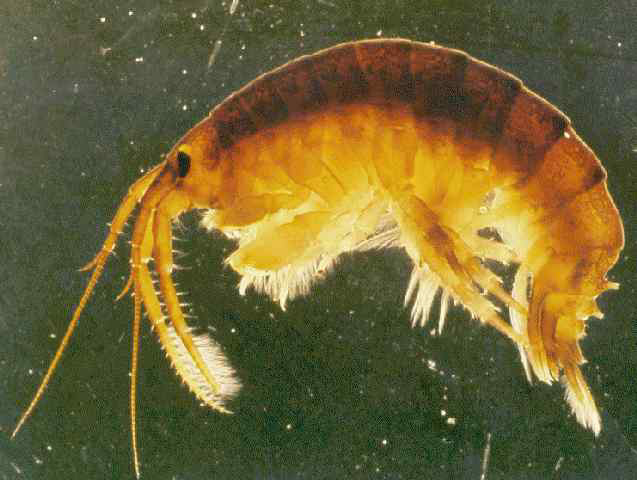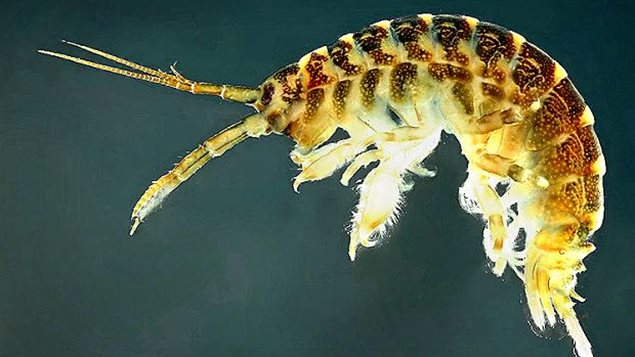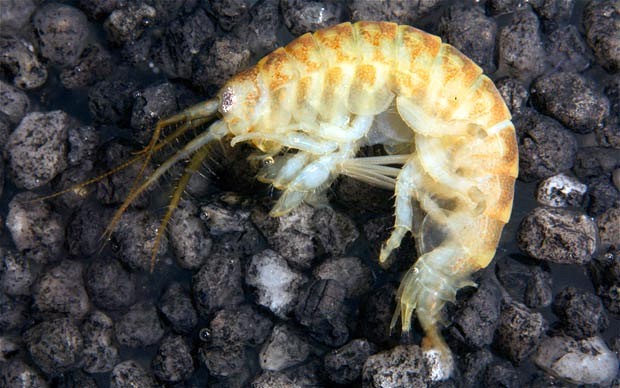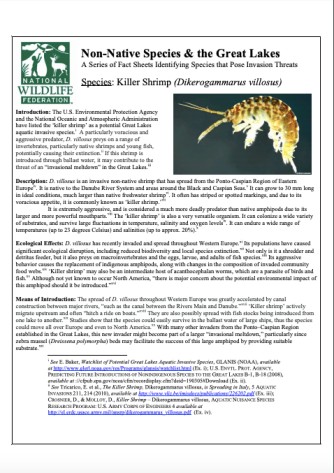Killer Shrimp (Dikerogammarus villosus)
French common name: Crevette tueuse

Killer shrimp are an aggressive predatory freshwater invasive invertebrate. They grow up to 3 cm long, have two tail cones, and two large, powerful mandibles.

Killer shrimp can either be solid in colour or have a striped pattern.
Photo Credit: Michal Grabowski/Enviroment Agency

Killer shrimp can survive up to four days out of water.
Photo Credit: Michal Grabowski/Enviroment Agency
Order: Amphipods
Family: Gammaridae
Killer shrimp are an aggressive predatory freshwater invasive invertebrate. They grow up to 3 cm long, have two tail cones, and two large, powerful mandibles. Killer shrimp can either be solid in colour or have a striped pattern. Killer shrimp are named because of their aggressive feeding habits; they consume large amounts of aquatic insect larva and food that native fish rely on. They also kill large amounts of organisms but don’t actually consume them. This behaviour disrupts food webs and decreases biodiversity. Killer shrimp can survive up to four days out of water, making it very easy to accidentally transfer them from waterbody to waterbody. It is very important that all fishing equipment is properly cleaned between uses and that your boat is washed off before switching waterbodies.
Killer shrimp has a typical laterally compressed, arched, and semi-transparent body. The maximum reported body length is 30 mm (Nesemann et al. 1995). The species demonstrates pigmentation polymorphisms, with striped, spotted and uniform morphs. Other prominent morphological features of the species include large and powerful mandibles that make it an effective predator (Mayer et al., 2008). Juvenile individuals resemble adults, but are much smaller in size. Their growth undergoes a number of moultings. Detailed descriptions of D. villosus morphology can be found in Carausu (1943), Eggers and Martens (2001), and Konopacka (2004).

Killer shrimp are a recent invader of Central and Western Europe freshwater ecosystems. Killer shrimp are originally native to the lower reaches of the rivers discharging into the Black and Caspian Seas (Dedju 1967; Nesemann et al. 1995; Vaate et al. 2002). They are widely distributed in the lower reaches of the Danube River system in the region of Eastern Europe/Ukraine (Mordukhai-Boltowskoi 1969; Nesemann et al. 1995). Its original distribution was restricted to the lower Danube by the narrow valley of the Dunakanyar near the confluence of the Danube and Ipoly Rivers (Nesemann et al. 1995).
This species has been nicknamed the “killer shrimp” for its extremely aggressive behaviour towards native invertebrate species. Due to their large body size and well developed mouthparts, killer shrimp are effective predators, which kill or simply bite off much more prey than they can consume (Dick et al., 2002).
In all the European aquatic systems where it has become established, D. villosus has largely replaced both indigenous and exotic amphipod species (Kelleher et al. 1999). In addition, this species readily consumes fish eggs (Casselato et al. 2007) and even attacks fish larvae (Schmidt and Josens, 2004). Due to its predatory activities, D. villosus significantly changes natural food webs of invaded ecosystems and occupies high trophic levels comparable to fish (Van Riel et al. 2006).
Fact Sheets
Best Management Practices

Lorem ipsum dolor sit amet, consectetur adipiscing elit. Ut elit tellus, luctus nec ullamcorper mattis, pulvinar dapibus leo.
Articles
[PDF] The profile of a ‘perfect’invader–the case of killer shrimp, Dikerogammarus villosus
alien species in Europe, in terms of negative impacts on the biodiversity and functioning of
invaded ecosystems. During the last twenty years, this Ponto-Caspian amphipod crustacean …
Potential effects of the invasive ‘killer shrimp‘ (Dikerogammarus villosus) on macroinvertebrate assemblages and biomonitoring indices
used to assess the potential impacts of the crustacean amphipod invader Dikerogammarus
villosus on resident macroinvertebrate assemblage structure in Central European fresh …
[HTML] Out of the Black Sea: phylogeography of the invasive killer shrimp Dikerogammarus villosus across Europe
water bodies in less than 20 years, having deteriorating effect on the local benthic
communities. Our aim was to reveal the species phylogeography in the native Black Sea
Application of bioclimatic models coupled with network analysis for risk assessment of the killer shrimp, Dikerogammarus villosus, in Great Britain
the aquatic invader Dikerogammarus villosus in Great Britain at multiple scales. First,
bioclimatic models (Support Vector Machine algorithm) were used to identify regions …
Current Research and Knowledge Gaps
Lorem ipsum dolor sit amet, consectetur adipiscing elit. Ut elit tellus, luctus nec ullamcorper mattis, pulvinar dapibus leo.
Further Reading
The Invasive Species Centre aims to connect stakeholders. The following information below link to resources that have been created by external organizations.

